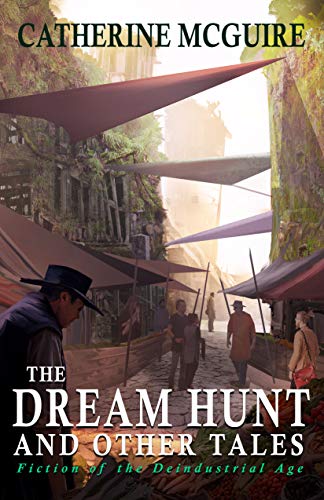 The Dream Hunt and Other Tales: Fiction of the Deindustrial Age
The Dream Hunt and Other Tales: Fiction of the Deindustrial Age
By Catherine McGuire
393 pp. Founders House Publishing – Sep. 2019. $17.99.
How will future generations fare in the world of scarcity and instability to which our present-day actions are consigning them? Catherine McGuire’s short story collection The Dream Hunt and Other Tales suggests a multitude of possible answers to this. Their common theme is that the future is far more likely to look like the preindustrial past than the present, and it has little chance of resembling the fanciful futures of 1950s science fiction. That’s because McGuire’s is a more grounded brand of sci-fi, one that takes account of the ecological realities that stand in the way of our cherished ideal of endless growth.
Dream Hunt contains 12 stories: an additional five to the seven already published in Into the Ruins magazine and the After Oil anthology series. Most are self-contained and make no reference to one another, though they absolutely could all take place in a single, shared future. The settings include various parts of what today is America, with characters referencing a host of mostly still recognizable place names like “Miss Ipi,” “Ohigh,” “the Codas” and “the Michgun Sea.” Yet some of the most fascinating territory covered in these stories lies completely outside the domain of physical geography, venturing firmly into the paranormal realm.
The lead story, “The Going,” depicts a future in which the medical treatments we take for granted today have become prohibitively expensive for most people, so much so that procuring drugs for diabetes and other chronic conditions means forfeiting your family’s life savings. Jeff, a middle-aged farmer who has long been living with untreated diabetes, stokes discord within his family when he reveals his desire to travel to the nearest hospital in search of insulin to shore up his deteriorating health. His relatives are aghast that he’s willing to fritter away his daughter’s dowry in exchange for a few more years of life. The story culminates with one of Jeff’s younger relatives sitting him down for a fatherly talk. Their conversation brings into focus the stark generation gap that exists in this future, in which Jeff and many of his peers cling to the luxuries of early-21st-century life while the younger generation accepts the new reality.
“‘Naut” centers on the return home of an explorer long feared dead. Travel has become so arduous and dangerous that few who attempt it come back. The “USAnauts” are an elite breed of men and women sent out to catalogue what remains of the outside world. They identify which places are still inhabited, which ones might yield salvage or potential trading partners and which are best avoided, all the while in great peril from roving barbarians. Every returning ‘naut receives a hero’s welcome, a homestead and plenty of romantic prospects. But internally they’re like soldiers coming back from war, harboring deep traumas and spiritual wounds. The characters in this story are particularly finely drawn, the conflicts quite compelling.
“Shifting Gears” is a fascinating tale of conceptual breakthrough. Set in a town in which machines—defined as tools that circumvent the need for human or animal muscle power—have been banned, it shows how one mechanically inclined young man does the unthinkable by redesigning a bicycle-powered thresher to run on river currents instead. Though condemned initially, the young man’s actions ultimately prompt the town’s leaders to question their long-held criteria for differentiating machines from tools.
This last story hits on a core theme of the book: the juxtaposition of modern technologies with those of the past. Like fellow deindustrial fiction author John Michael Greer, McGuire challenges us to think more broadly about technology, and to question our society’s disdain for those who reject things from the present in favor of those from the past. In the worlds of Dream Hunt, people pick and choose technologies from various eras, arriving at whichever combinations best suit their needs. Thus, oil sconces coexist with solar-powered lamps, horse-drawn carriages share the road with wood-fired buggies, goods are paid for in barter chits as well as dollars and clocks are used along with sundials. Greer and McGuire both contend that this sort of technological bricolage is likely to become common in the real world as the spiraling crises of resource scarcity, climate disruption and social unrest make it increasingly difficult to maintain our current technological landscape in its entirety.
Another commonly held assumption that McGuire and Greer seek to dispel is that those who advocate reviving old technologies must also favor a return to oppressive social attitudes and norms of the past. Greer’s novel Retrotopia strives to show how baseless this assumption is by placing modern progressive ideals like marriage equality alongside technologies from eras that lacked our current progressive views. McGuire echoes this hopeful message by including in her stories strong, complex female characters, openly same-sex relationships and other happy vestiges of today’s zeitgeist.
“Root and Branch” examines how our ideals around marriage could evolve in an increasingly local, community-centered world. The story is about a feuding couple whose fate rests in the hands of the local “harmony council.” Unlike in today’s world, where success in marriage is a coin flip, couples rarely separate in this future. When a couple does start having problems, it’s a public rather than private matter, representing an intolerable disruption to the community’s well-being. A council convenes publicly to resolve the conflict. If the partners are unable or unwilling to reconcile for the sake of the community’s health—which takes precedence over their own individual happiness—the council has the power to break them up, decide the custody of any children and even remove parties in conflict from the community.
A recurrent theme in these stories is how unforgiving the deindustrial future is toward those who go astray, fail to conform or simply draw the short straw. The community depicted in “Singing the World” has a superstition that compels people to sing songs of gratitude during every activity of their waking lives, and those who lack singing ability are forced to cast their lot with a tribe of nomadic heathens. “Scapegoat” is a fresh take on Shirley Jackson’s famous short story “The Lottery,” the key difference being that rather than facing death by stoning, winners are banished to a toxic no-man’s-land as a gesture of atonement for the ecological destruction wrought by previous generations. “The Balance Within” is set in a place that metes out draconian punishments to out-of-towners caught spying within its borders.
Dream Hunt may be at its most affecting when undertaking its forays into the paranormal. In “Windfall,” a young girl implores the wind to rid her family of a thieving bully, and the request is heeded—though whether by divine intervention or pure chance, we aren’t told. And the book ends with a trio of mesmerizing tales about a sinister, fog-like alternate dimension that abducts people and returns them in a tragically vacant state. These last three pieces—one of which is the title story, “Dream Hunt”—worm their way into your brain and really make you think, which to me is a mark of truly great sci-fi.
The adventurer’s sense of wonder at discovering new worlds and possibilities is another mainstay of sci-fi that McGuire evokes quite effectively. Consider a scene in which one character passes through a street market and stares awestruck at a collection of antique fabrics: “Rya drank in the glowing pinks, turquoise, and colors for which there were no names.” Because hers is a world in which synthetic dyes can no longer be made, these colors seem as wondrous to her as the halo of light around a black hole does to us. We witness two other characters delight in the phenomenon of snow—a substance that is “like ice, but soft”—for the first time. And we hear fantastic tales of a people who live inside a mountain, using ladders to connect their streets and the entire mountaintop as one vast water catchment basin.
One thing I especially admire about these stories is their terrific variety in terms of time period and milieu. Some are set in far-future worlds bearing little resemblance to today, while others take place in settings filled with remnants of the industrial era. (As one example of the latter, I was amused to see a character dine on decades-old breakfast cereal. Froot Loops, it seems, rank right up there with Twinkies in their otherworldly imperviousness to spoilage.) I fully expect McGuire to continue developing these worlds of hers in future stories—whose advent I welcome wholeheartedly.






